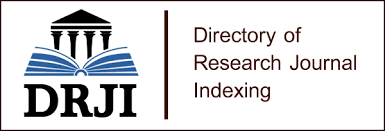IMPACT OF HUMAN RESOURCE MANAGEMENT PRACTICES ON THE GENDER ORIENTATION OF THE EMPLOYEES AND THEIR FAMILIES: EVIDENCES OF SOCIAL CHANGE FROM PAKISTAN
Abstract
The western human resource management practices are employed in the modern organizations of Pakistan is work on the principle of gender egalitarian. Contrary to this, Pakistani social values are based on the principle of gender segregation. To cope up with this situation mix workplace culture has been developed in modern organization in Pakistan. This mix workplace culture is influencing the not only gender behavior of the employees in the organizations but also out of the organizations in their familial context. This paper is going to explore the ways gender egalitarianism (the basic constituents of HRM practices) influence gender related behavior of employees and their families specifically in the context of Pakistan. To actualize the demand of this research, quantitative research approach has been used in this study. Using convenience sampling technique, data was collected through self administered questionnaires from 513 employees of different service sector firms in the twin cities of Pakistan (Rawalpindi and Islamabad). The main findings of the study highlighted that western human resource management practices are fairly influencing employees’ gender specific behavior in the domain of seating arrangements and male-female direct interaction patterns
Â
References
Ahmad, F. and Sultan, M. (2004). Women's empowerment and mobility in Pakistan: Result from a National Survey. Paper presented at Fifth Annual Research conference 14-16 December, Karachi, Pakistan.
Ali, F. and K. Angela, (2008). Pakistan's commitment to equal employment opportunity for women: A toothless tiger? International Journal of Employment Studies 16 (1) p. 39-58.
Bhalla, S. S, and Kaur, R. (2011). Labour force participation of women in India: Some facts, some queries. Asia Research Centre.
Blanchet D, Pennce, S. (1993). A simple model for interpreting cross tabulations of family size and women's labour force participation. European Journal of Population. 121-142.
Chang, T. P. (1992). Implication of changing family structure on old age support in the ESCAP region. Asia Pac Popul J 1992; 7:49-66.
Crompton, R. (2006). Employment and the family: The reconfiguration of work and family life in contemporary societies. 1st Edn, Cambridge University Press, New York, ISBN-10: 0521840910, pp: 244.
Dutceac, A. (2004). “Globalization and ethnic conflict: Beyond the liberal – nationalist distinction. The global review of ethno politics, 3(2): 20-39.
Gazdar, H. (2008). No longer worried about becoming a ‘free sex zone’. Economic and Political Weekly, 43, 17, 8–9.
Goheer, N.A. (2003). Women Entrepreneurs in Pakistan: How to Improve Their Bargaining Power. Geneva: International Labour Organisation.
Grunenfelder, J. (2012). Gender, work and development in northwest Pakistan: working environments of Pakistani female development Practitioners Originally published at: University of Zurich, Faculty of Science.
Hafeez, S. (1991). Social Structure of Pakistan: Developing Some Concepts. In The Changing Pakistani Society. Sabeeha Hafeez (eds.) 1-38.Karachi: Laureate Packages.
Horwitz, S. (2007). Capitalism and the family: The market economy is responsible for ever-changing family structure. http://www.fee.org/the_freeman/detail/capitalism-and-the-family
Jaumotte, F. (2005). Female labour force participation: Past trends and main determinants in OECD countries. Presentation at the ‘labour force participation and economic growth workshop.
Jejeebhoy, S. J. (2000). Women’s autonomy in rural India: Its dimensions, determinants, and the influence of context. Women’s empowerment and demographic processes: Moving beyond Cairo, 1.
Kessler & MckIna. (1978). Genderan ethno-methodological approach. University of Chicago Press.
Khan, S. (1995). Pakistan: Past, Present and Future. Lahore: Aalameen Publication Press.
Khan, M. S., Harper, D., Page, S., Ahmad, H. (2011). Residual value analyses of the medicinal flora of the western Himalayas: The Naran Valley, Pakistan. Pak. J. Bot., 43: 97-104.
Kishor, S. (2000). Empowerment of women in Egypt and links to the survival of their infants. In women’s empowerment and demographic processes: Moving beyond Cairo, ed. H. Presser and G. Sen. New York: Oxford University Press.
Koller, V. (2004). Metaphor and gender in business media discourse, Basingstoke.
Lindholm, C. (1996). Frontier perspective: essays in comparative anthropology. Karachi: Oxford University Press.
Luthans, F. (1998). Organizational Behavior. New York: McGraw Hill.
Lyon, S. (2002). Power and Patronage in Pakistan, Unpublished PhD Dissertation, Unpublished PhD Dissertation, University of Kent, Canterbury.
Mirza, J. (1999). Accommodating Purdah to the workplace: gender relations in the office sector in Pakistan. Pakistan Development Review, 38, 2, 187-20.iversity of Kent, Canterbury.
Mirza, J (2002). Between chador and the market. Oxford: Oxford University press.
Mosse, J.C. (1993). Half the World, Half a Chance. An Introduction to Gender and Development. Oxfam UK, Oxford.
Myers, R. (1992). The twelve who survive: Strengthening early childhood care and development programmes in the third world. Routledge, London.
Papanek, H. (1973). Purdah: Separate worlds and symbolic shelter. Comparative studies in society and history, 15, 3, 289-325.
Rizvi, U. (2008). Jazbah Magazine women of Pakistan [Review of the book Taboo and Between Chaddor and the Market: Jazbah Magazine women of Pakistan.
Rosen, S. (1996). Public Employement and the welfare state in Sweden. Journal of Economics Literature. Vol. 34, 729-740.
Rozario, S. (2001). Claiming the campus for female students in Bangladesh. 24 (2), 157-166.
Saher, N & W. Mayrhofer. (2013). The Role of Vartan Bhanji in Implementing HRM Practices in Pakistan. The International Journal of Human Resource Management. DOI: 10.1080/09585192.2013.863792. http://www.tandfonline.com/eprint/ey4JBxvsEm5AQX7vuG3R/full#.UqlMjfSw13g
Saher, N. (2010). Cultural Diversity and Human Resource Development in Modern Organization. A PhD. Dissertation, Department of Anthropology, Quaid-e-Azam University, Islamabad-Pakistan.
Shaheed, F. (2010). Contested Identities: gendered politics, gendered religion in Pakistan. Third World Quarterly, 31, 6, 851–67.
Shehab, R. (1989). History of Pakistan. Lahore: Sang-e-Meel Publications.
Spiegel, D. (1993). Pakistan. Jenseits des Teppichs. Weekly Magazine, No. 40. Berlin.
Stoller, R. (1968). Sex and Gender: On the Development of Masculinity and Femininity, Science House, New York City.
Storti, C.(1990). The Art of crossing cultures, yarmouth, ME: Intercultural Press.
Syed, J., F. Ali & D. Winstanley. (2005). In pursuit of modesty: Contextual emotional labour and the dilemma for working women in Islamic societies. International Journal of Work Organization and Emotion, 1 (2). Pp. 150-167. ISSN 1740-8938.
Tanses, A. (2002). Determinants of school attainment of boys and girls in Turkey: Individual, household and community factors. Economics of education review 21. 455-470.
Trompenaars, F. (1994). Riding the waves of culture: Understanding Cultural Diversity in Business. Finland: Werner Soderstorm.
Valsbem, J, Schippers, J. (2004). Increase in female labour force participation in Europe, similarities and differences. European Journal of Population. 20 (4) 375-392.
Published
How to Cite
Issue
Section
License
Copyrights for articles published in Journal of Asian and African Social Science and Humanities are retained by the authors, with first publication rights granted to the journal. The journal/publisher is not responsible for subsequent uses of the work. It is the author's responsibility to bring an infringement action if so desired by the author.
Articles published in Journal of Asian and African Social Science and Humanities are published under the Creative Commons Attribution (CC-BY) license, which permits others to distribute, remix, tweak, and build upon your work as long as they credit you for the original creation.
Â














